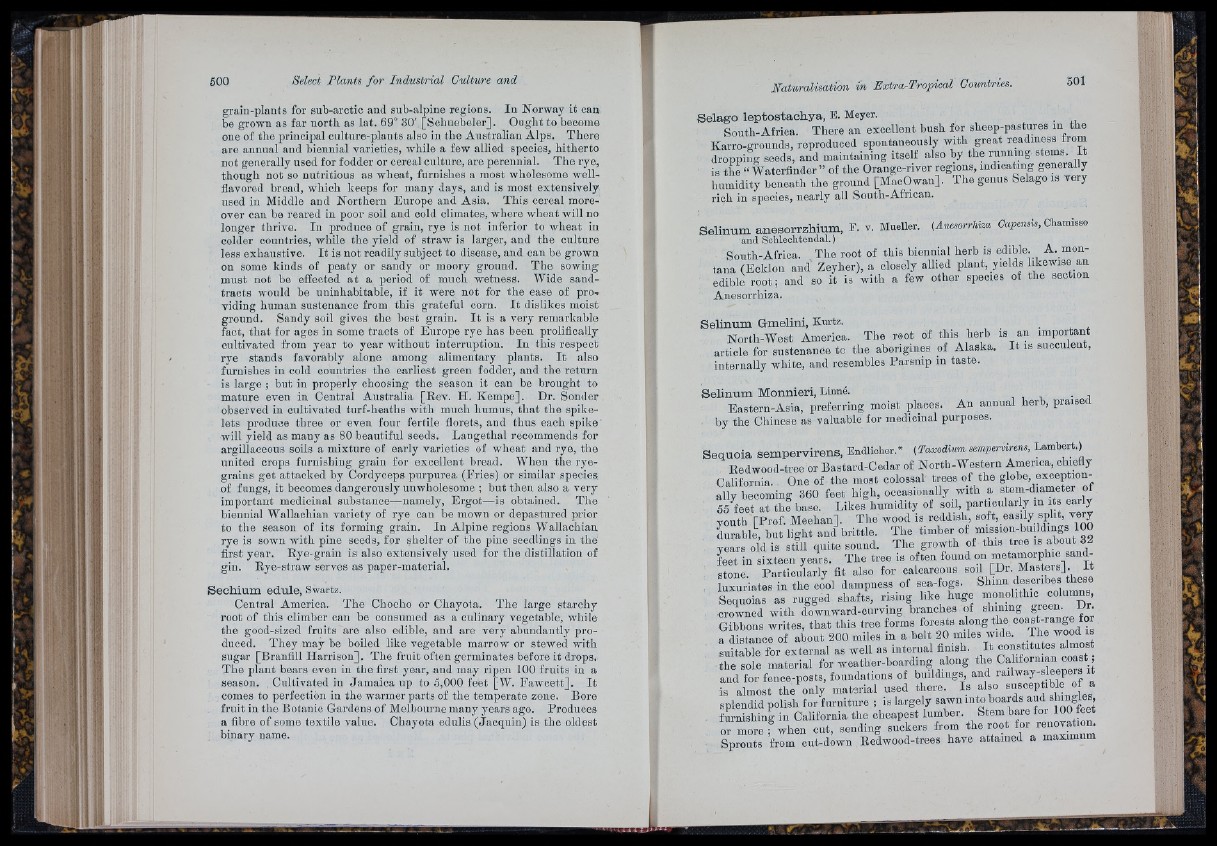
grain-plants for sub-arctic and sub-alpine regions. In Norway it can
be grown as far north as lat. 69° 30' [Schuebeler]. Ought to become
one of the principal culture-plants also in the Australian Alps. There
are annual and biennial varieties, while a few allied species, hitherto
not generally used for fodder or cereal culture, are perennial. The rye,
though not so nutritious as wlieat, furnishes a most wholesome well-
fiavored bread, which keeps for many days, and is most extensively
used in Middle and Northern Europe and Asia. This cereal moreover
can be reared in poor soil and cold climates, where wlieat will no
longer thrive. In produce of grain, rye is not inferior to wheat iu
colder countries, while the yield of straw is larger, and the culture
less exhaustive. I t is not readily subject to disease, and can be grown
on some kinds of peaty or sandy or moory ground. The sowing
must not be effected a t a period of much wetness. Wide sand-
tracts would be uninhabitable, if it were not for the ease of pro»
viding human sustenance from this grateful corn. I t dislikes moist
ground. Sandy soil gives the best grain. I t is a very remarkable
fact, that for ages in some tracts of Europe rye has been prolifically
cultivated from year to year without interruption. In this respect
rye stands favorably alone among alimentary plants. I t also
furnishes in cold countries the earliest green fodder, and the return
is large ; but in properly choosing the season it can be brought to
mature even in Central Australia [Kev. II. Kempe]. Dr. Sonder
observed in cultivated turf-heaths with much humus, th a t the spike-
lets produce three or even four fertile florets, and thus each spike
will yield as many as 80 beautiful seeds. Langethal recommends for
argillaceous soils a mixture of early varieties of wheat and rye, tlie
united crops furnishing grain for excellent bread. When the rye-
grains get attacked by Cordyoeps purpurea (Fries) or similar species
of fungs, it beoomes dangerously unwholesome ; but then also a very
important medicinal substance—namely. Ergot—is obtained. The
biennial Wallachian variety of rye can be mown or depastured prior
to the season of its forming grain. In Alpine regions Wallachian
rye is sown with pine seeds, for shelter of the pine seedlings in the
first year. Rye-grain is also extensively used for the distillation of
gin. Rye-straw serves as paper-material.
Seohium edule, Swartz.
Central America. The Choelio or Chayofa. The large starchy
root of this climber can he consumed as a culinary vegetable, while
the good-sized fruits are also edible, and are very abundantly produced.
They may be boiled like vegetable marrow or stewed with
sugar [Branfill Harrison]. The fruit often germinates before it drops.
The plant bears even in the first year, aud may ripen 100 fruits in a
season. Cultivated in Jamaica up to 5,000 feet [W. Fawcett]. I t
comes to perfection iu the warmer parts of the temperate zone. Bore
fruit in the Botanic Gardens of Melbourne many years ago. Produces
a fibre of some textile value. Chayota edulis (Jacquin) is the oldest
binary name.
Selago leptostachya, E. Meyer.
South-Africa. There an excellent bush for sheep-pastures m the
Karro-grounds, reproduced spontaneously with great readiness from
dropping seeds, and maintaining itself also by the running stems. I t
is the “ Waterfinder ” of the Orange-river regions, indicating generally
humidity beneath the ground [MacOwan]. The genus Selago is very
rich in species, nearly all South-African.
Selinum anesorrzhium, E. v. Mueller,
and Schlechtendal.)
{Anesorrhim Capensis, Chamisso
South-Africa. The root of this biennial herb is edible. A. montana
(Ecklon and Zeyher), a closely allied plant, yields ^
edible root; and so it is with a few other species of the section
Anesorrhiza.
Selinum Gmelini, Kurtz. . .
North-West America. The root of this herb is an important
article for sustenance to the aborigines of Alaska. I t is succulent,
internally white, and resembles Parsnip m taste.
Selinum Monnieri, Linné.
Eastern-Asia, preferring moist places. An annual herb, praised
by the Chinese as valuable for medicinal purposes.
Sequoia sempervirens, Endlicher.* (Taxodium sempervirens, Lambert.)
Redwood-tree or Bastard-Cedar of Nortli-Western America, chiefly
California. One of the most colossal trees of the globe exceptionally
becoming 360 feet high, oecasionally with a stem-diameter of
55 feet at the base. Likes humidity of soil, particularly in its early
yontli [Prof. Meehan]. The wood is reddish, soft, easily split, very
L ra b le , hut light and brittle. The timber of missiou-buJdmgs 100
years old is still quite sound. The growth of this tree is about 32
feet in sixteen years. The tree is often found on metamorphic sandstone.
Particularly fit also for calcareous J *
luxuriates in the cool dampness of sea-fogs. Shinn describes these
Sequoias as rugged shafts, rising like huge monolithic columns,
crowned with downward-curving branches of shining green. Dr.
Gibbons writes, th a t this tree forms forests along the ««“sLrange for
a distance of about 200 miles in a belt 20 miles wide. The wood is
suitable for external as well as internal finish. I t contiitutes almost
the sole material for weather-boarding along the it
and for fence-posts, foundations of buildings and ®®P®«
is almost the only material used there. Is also susceptible ot a
splendid polish for furniture ; is largely sawn into boards ®
furnishing in California the cheapest lumber. Stem bare for 100 feet
or more ; when cut, sending suckers from the root for
Sprouts from cut-down Eedwood-trees have attained a maximu
lA-'k